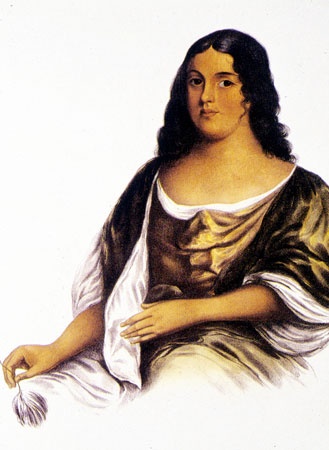Powhatan
American Indian chief
also called Wahunsenacah or Wahunsenacawh
died April 1618, Virginia 【U.S.】
North American Indian leader, father of Pocahontas. He presided over the Powhatan empire at the time the English established the Jamestown Colony (1607).
Powhatan had inherited rulership of an empire of six tribes from his father. After succeeding his father, Powhatan brought about two dozen other tribes into the empire that was named for him; at the peak of his power, he is estimated to have ruled between 13,000 and 34,000 people. Powhatan was an astute and energetic ruler, but he was also noted as being strict and occasionally cruel toward his subjects. In the Algonquian language (Algonquian languages) of his people, his title as emperor was mamanatowick, and his territory was known as Tsenacommacah. Each tribe within the Powhatan empire had its own chief, or weroance, and Powhatan ruled as the chief of these chiefs.
English colonists established a settlement, known as Jamestown, on an uninhabited peninsula within his territory in 1607. The Powhatan empire at the time of the colonists' arrival essentially covered present-day eastern Virginia, extending from the Potomac River to the Great Dismal Swamp, and its capital was at the village of Werowocomoco. Powhatan initially acted ambivalently toward the English settlement, sometimes ordering or permitting attacks against the colonists while at other times trading tribal food for sought-after English goods such as metal tools. During the colony's early years, he appears to have viewed the English as potential allies against his own enemies—namely, the Monacan, Mannahoac, and Massawomeck tribes to the north and west. In his trading and negotiation with the colony in those years, the English were generally represented by John Smith (Smith, John), with whom Powhatan played a cat-and-mouse game as each side assessed the other's capabilities and intentions.
In an ill-conceived attempt to win Powhatan's favour, the Virginia Company of London—the sponsor of the colony—ordered the colonists to present Powhatan with a royal crown and gifts in 1609, symbolizing that he would henceforth be a prince in the service of King James I. Powhatan rejected this notion. Beginning in the autumn of 1609, following Smith's departure for England, Powhatan came to believe that the English could be starved into submission. He cut off all trading with the colonists and attacked any of them who left the Jamestown fort. Some 80 percent of the colonists died, and Jamestown would have been abandoned except for the timely arrival of supply ships and new colonists the following spring.
 In April 1614 Pocahontas married the planter John Rolfe (Rolfe, John) with Powhatan's approval. The marriage resulted in generally friendly relations between the English and the Powhatan Indians, which persisted for a while after the chief's death.
In April 1614 Pocahontas married the planter John Rolfe (Rolfe, John) with Powhatan's approval. The marriage resulted in generally friendly relations between the English and the Powhatan Indians, which persisted for a while after the chief's death.Archaeologists in 2003 located the probable site of Powhatan's 1607 capital, Werowocomoco, on the York River in Gloucester county, Virginia.
Additional Reading
Powhatan's life, with a focus on his interactions with the English colonists, is described in David A. Price, Love and Hate in Jamestown: John Smith, Pocahontas, and the Heart of a New Nation (2003).
North American Indian confederacy
 confederacy of at least 30 Algonquian (Algonquian languages)-speaking North American Indian tribes that once occupied most of what is now tidewater Virginia, the eastern shore of the Chesapeake Bay, and possibly southern Maryland. The confederacy had been formed by and named for a powerful chief, Powhatan, shortly before the colonial settlement of Jamestown in 1607. The tribes of the confederacy provided mutual military support and paid taxes to Powhatan in the form of food, pelts, copper, and pearls. Many of the confederacy's villages, which consisted of long dwellings covered with bark or reed mats, were palisaded; they were situated near fields in which women cultivated corn (maize), beans, squash, and other vegetables. Men were occupied with hunting and warfare.
confederacy of at least 30 Algonquian (Algonquian languages)-speaking North American Indian tribes that once occupied most of what is now tidewater Virginia, the eastern shore of the Chesapeake Bay, and possibly southern Maryland. The confederacy had been formed by and named for a powerful chief, Powhatan, shortly before the colonial settlement of Jamestown in 1607. The tribes of the confederacy provided mutual military support and paid taxes to Powhatan in the form of food, pelts, copper, and pearls. Many of the confederacy's villages, which consisted of long dwellings covered with bark or reed mats, were palisaded; they were situated near fields in which women cultivated corn (maize), beans, squash, and other vegetables. Men were occupied with hunting and warfare.Hostilities developed between the Powhatan confederacy and the English settlers and resulted in intermittent fighting until 1676. Long-standing conflicts with the Iroquois were ended by a treaty in 1722, but the greatly reduced Powhatan population continued to decline. Those on the eastern shore of Virginia, who had long intermarried with free and enslaved Africans, were driven off in 1831 during the disturbances caused by a slave rebellion (slave rebellions) led by Nat Turner.
In the early 21st century population estimates indicated approximately 2,000 individuals of Powhatan descent.
- Justus Lipsius
- Justus Möser
- Justus of Ghent
- Justus, Saint
- Justus van Effen
- just war
- Jute
- jute
- Jutiapa
- Juticalpa
- Jutland
- Jutland, Battle of
- Juvarra, Filippo
- Juvenal
- Juvenalian satire
- Juvenal, Saint
- juvenile court
- juvenile delinquent
- juvenile hormone
- juvenile justice
- Juventud, Isla de la
- Juxon, William
- Juárez
- Juárez, Benito
- J. Walter Thompson Co.